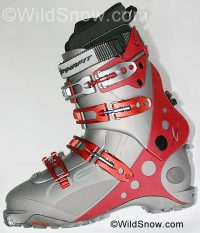Along with gradually getting my ski legs back, I’ve been tweaking the Freeride Aero backcountry skiing boots that we first-looked a while back. A good test for this type of boot is to ski lift-served expert terrain, so that’s what we did today. A few runs on the new Aspen Highlands Temerity lift to burn the quads, then over to Aspen Mountain for a bit of mellow cruising. I can easily say these boots are the closest thing to an alpine boot I’ve ever used as an AT boot. Not quite there (a good thing, otherwise they’d weigh too much), but near enough that I’d use them for all but the longest days at a ski area.
Here is my experience in detail: The Aeros had too much forward cuff angle (lean) for my upright skiing stance. Reducing that by a small increment required removing the screw rivet that holds the lean-lock mechanism, elongating the hole, then replacing the screw and using JB-Weld epoxy to fill the resulting void above the screw. I also had to shorten the flange on the screw rivet a bit, easily done with a file. While doing this, I noticed that the boots have a very obvious configuration for ADDING forward lean. Everything is there, you just drill a new hole for the screw rivet at your lean angle of choice. Many of my friends seem to always want more forward lean out of their AT boots — let it be known this is VERY easy to do with the Dynafit Aero. And as a reminder, this boot does NOT come with a cant rivet on the cuff, so I had to swap one in from a pair of Scarpa Lasers.
What else? I’m also preparing a sweet pair of this year’s Garmont Megarides for testing, and noticed that the Dynafit is a much more roomy boot than the Megarides in terms of foot volume. In other words, if you have narrow feet you might want to look at the Garmont first; with wide feet check out the Dynafit. A cool feature of the Dynafit is that the sole of the boot is filled in so it doesn’t catch on the Dynafit binding brake. Nice. And how about the new “semi step in” feature on the Dynafit toe sockets? It works. Not quite the “step in” of an alpine binding or Fritschi, but close. I haven’t found any deal-breaker problems, but did notice that the Aero walk/ski mode switch is a finicky dial-like affair that’s hard to turn with gloved hands, especially when extra-cold weather causes ice to form within the mechanism. Another gripe is that the tongue doesn’t have a hinge anchor, but rather is riveted to the shell. Without a hinge, getting in and out of the Aero requires quite a bit of dexterity and strength as you’ve got to bend the springy tongue out of the way with one hand while you hold the boot open with the other. This is an area where a mod might be on tap. And speaking of mods, I REALLY like the cool touring-mode catches on the Garmont buckles that hold the buckles nice and loose for touring, rather than having them flopping around. Yes, as we say around here “everything MUST be modified!”
My itty bitty gripes aside, this is a fine boot that I feel privileged to be using.
WildSnow.com publisher emeritus and founder Lou (Louis Dawson) has a 50+ years career in climbing, backcountry skiing and ski mountaineering. He was the first person in history to ski down all 54 Colorado 14,000-foot peaks, has authored numerous books about about backcountry skiing, and has skied from the summit of Denali in Alaska, North America’s highest mountain.

